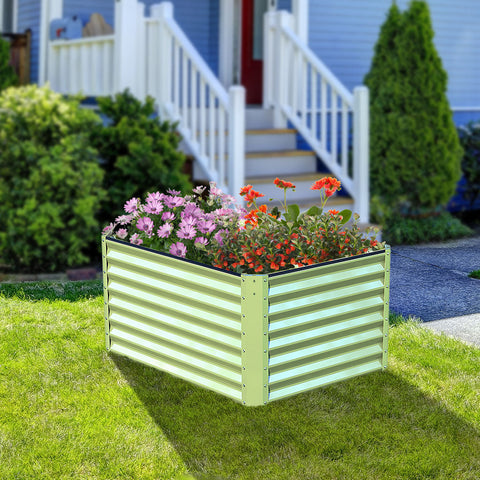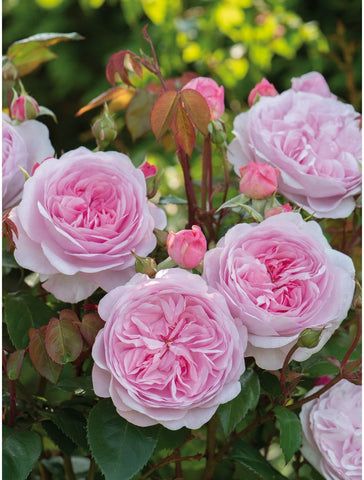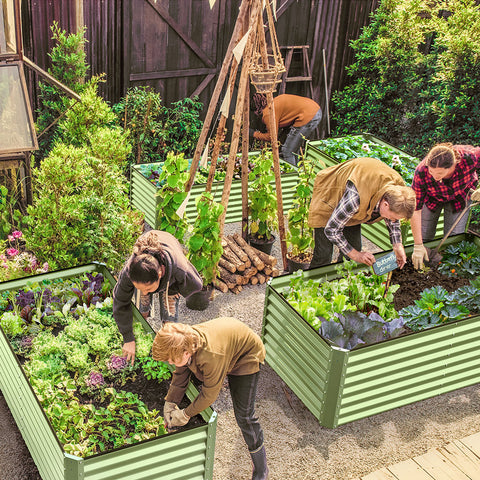Raised beds can be as humble or creative as you like, using brick, stone or uprecycled materials. An elevated bed planting can be a temporary or permanent fixture for plants to settle and mature. The initial cost of building a loft bed depends on how elaborate you are. You can make raised beds cheaply or for free if you make raised beds from old boards or used bricks. Once cultivated, the beds are no more expensive to maintain than traditional gardens. The following content also has some reference value for raised garden beds.
Depending on whether you want a permanent or temporary bed will determine the base materials you use. Some typical materials used to base your garden bed can include cardboard, newspaper, concrete, straw, mulch and wood shavings, leaves, grass clippers, rocks, hessian rope, wool, landscape fabric and plastic. If you have a large raised bed, you may want to use large rocks, plastic bottles or straw at the bottom so that the water drains out and does not collect or make the soil damp. Design drainage holes at the bottom of the seedbed.

You do not need to line the POTS with bricks or otherwise, however, it is recommended as it will keep burrowing animals away from your plant roots and will maintain good drainage without letting the soil run away.
What is a flower bed?
Raised gardening involves growing plants in soil above ground level. Your most common method is a fence or frame made from wood, rocks, bales of hay, or even recycled materials like old dressers.
The benefits of growing flower beds
Raised beds have many benefits, such as better soil drainage, increased planting depth so there is no stooping, and the ability to remove temporary structures if you change your mind about keeping them. Here are some advantages:
It's easier on the gardener's back
Look good
Pest invasion reduction
Improve drainage system
Fewer weeds
Better soil temperature
It can be temporary or permanent
Less attention to soil pollution
01 Custom-designed elevated bed
High bed gardens can accommodate almost any space. With creativity, you can create an entire garden sitting area. This multi-storey raised bed by Peter Donegan Landscape architects combines simple straight lines. It comes with a potting shed and a lamp post. Add a bench section, like the end of the front bed, and you have seating for the outdoor dining area. With plant growth and wood weathering, this garden will have a natural, rustic look.
02 Built-in red brick convex wake up
Red brick beds can enhance the design of your homestead or backyard. When you're making a raised bed, don't bury it in the ground, but place the bed where the sun or shade is best for the plants you want to grow.
Bricklaying is not for everyone. It takes a lot of patience and precision to do this right. Choose bricks that will survive constant wet conditions. Most red brick elevated beds are built with mortar to keep the walls intact.

03 Planting bag bed
Another huge advantage of elevated bed gardens is that they sit above the underground frost line, so the soil warms up faster in the spring and you can start planting earlier.
The materials used in beds differ in this respect: metals absorb more of the sun's heat. But planting bags are a good choice because they don't freeze solid and the soil inside thaws quickly. Plus, it's a great way to provide heat for growing Mediterranean plants like sage and lavender. Planter bags may seem too easy, but within minutes you can have a great nurturing bed garden.
04 Herb Spiral Garden
Spiral gardens are a popular permaculture technique. They increase the amount of acreage available for planting without taking up more ground space in the garden. You can easily build them out of stone, brick, or wood, or simply pile up the dirt.
The unusual shapes and swirls of plants make your garden a striking focal point. Herbs are the choice for this photo, but you can grow just about anything with a spiral design.
05 Trough garden
One of the easiest ways to do this is to use an animal feed trough. No assembly required, but be sure to drill some drainage holes in the bottom before adding soil. The metal gives the garden an industrial look and conducts heat, warming the soil in the spring.
You can use new or used slots, depending on availability and the look you want. Depending on what you choose to plant, plants may need extra moisture during the hottest part of the summer.
06 square foot loft bed
Square foot gardening involves dividing the planting area into small square areas, usually 1 foot per square. The aim is to produce a densely planted vegetable garden or a high-yield kitchen garden. This can be measured and divided with a variety of materials, including nets.
Using raised beds to grow vegetables allows you to control the quality of the soil and prevent it from becoming dense. The roots of vegetables can grow unimpeded. The bed doesn't have to be high off the ground to benefit from a raised bed. Even 6 to 8 inches is enough.
07 Flower box as raised flower bed
Raised beds have few limitations. If you have a sturdy fence, you can attach some wooden boxes to your fence for small raised beds, like windowsill boxes. These annuals take over when perennials stop flowering. You can also decorate these places with seasonal greens and decorations for a unique decorating idea during the winter holidays.
08 cinder block overhead bed
There are many ways to build raised beds from recycled materials. Concrete blocks or cinder blocks are the most popular kind. Some older cinder blocks may contain fly ash, the "cinder" that remains after coal is burned. Whether it is safe to use around edible plants remains controversial. If you use concrete blocks, you can avoid the ash problem. The new cinder blocks are much heavier than the old ones, but they're okay for a vegetable garden.
Be careful though, concrete blocks can absorb lime. Lime can raise the ph of the soil. To be safe, use plants that thrive in alkaline soil. These sturdy succulents and sedums are hardy and not too fussy about the soil, so they are a good choice for these growers.

09 Hoop house raised bed
With a little planning, you can create a multi-season garden. Raised beds give you more flexibility to control growing conditions in your garden, making it harder for animals to access your vegetables. If you build a ring house on a raised bed, you can be prepared for any weather, deal with frost, and give yourself a head start in the spring. The lightweight net is strong enough to cover a cloth in case of frost.
10 Raise the edge of the bed
Raised beds are an excellent choice for yards with steep slopes. By building the bed in the lowest section, you can create the illusion of a horizontal garden. Make your bed wide enough so that you can still have a layered garden with shrub edges at the back and plenty of room for perennials that provide color, texture and curtains that soften the edges.
- Space saving design concept
Gardeners with limited space can often be creative with raised bed designs to make the most of what they have. This clever design places a wooden flower bed (made of recycled materials) on top of the bin storage area: refreshing this usually drab place and bringing beauty to a functional area. String lights and decorations add a personal touch.
12 Elevated gazebo
Vertical gardening allows you to grow more plants without taking up more space. Using a trellis or gazebo with a raised bed is easier to harvest vegetables and keep them tidy than spreading them out on the ground. This loft bed for growing zucchini shows that your design can be as simple as strapping two dowels (or bamboo poles) together and tying them together. Other crops may benefit from stretching garden nets across the grid structure.
13 Lasagna garden growing beds
Lasagna gardens are layered gardens that don't require digging, but the term means using materials other than soil beneath the topsoil layer. In this case, build wooden raised beds, fill them with cut wood and grass clippings, then add a layer of topsoil. If you're planting plants that don't have deep roots, this can reduce soil weight and cost.
14 Milk crate Garden
Reuse milk crates to make your loft bed portable. This milk bed is easy to set up and you can configure it in any shape you like. If you need your plants closer to the kitchen, or you want to keep them in a shady place, just pick up the crate and go. These containers already have drainage holes. And, when you need to change the soil, you can lift the crate, dump its contents into the compost pile and start over.
15 empty bed and container design
Maybe you have brick beds and want them to feel fuller and more decorative. Placing containers below the level of a brick wall allows you to play at different levels, drawing the eye, and allowing for almost unlimited sizes and shapes. You can even plan plantings to provide visual pleasure for all seasons. You can also move the container around at any time to change the design.
16 Tray Garden
You can make a plant wall out of recycled packaging pallets, or lay a pallet on the ground to serve as a raised bed with natural partitions between the slats to keep your plants in order. Pallets are usually available for free from businesses that do not have shipping services.
17 Reuse old desks
Style changes, or sometimes you want to give your room a makeover. Perhaps an old wooden kitchen table or coffee table is destined for the trash. Think again about throwing it away. Turn the legs or entire table into your next loft bed. Plant simple herbs that are perfect for picking at table level. Wood materials degrade over time, but you can hold out for a few more years before rotting.
18 rows of brick and cobblestone
Wall bricks and cobblestones were good enough for the ancient Egyptians and Romans and have been for thousands of years, so think dry piles, stacking rows of retaining wall bricks, red bricks or cobblestones to build a sturdy raised bed that can stand the test of time.
You don't need mortar, but if the stacking height is higher than 4 bricks (or 4 layers), you can use masonry adhesive to bond them together, which will make the structure last longer. For more stability, build a wall with an inner and outer layer, and use the thickness of two bricks or stones on all sides.

19 Furniture Redux
The table seems to be for a raised box that you can fill with dirt. But less obvious choices are old furniture such as dressers, chests of drawers, media centers, beds and cribs, and tubs destined for the trash heap. Old drawers are ideal for growing different plants.
Make it a goal
Villa gardens and elaborate landscaping often feature bench seating in picturesque locations. When designing a raised box from scratch, consider incorporating seating into your design.
The seating is a great place to enjoy the garden, but it also has a practical use. If you are building a high-bed garden box out of several feet of wood, the seats will make weeding, trimming and other maintenance issues easier to deal with.
21 Enclosed elevated bed
Deer, rabbits, and burrowing, foraging creatures can make a mess of your garden in minutes. If you are in an area where animal activity will ruin your garden's hopes, plan to enclose your raised bed. You can simply start with 3-foot corner posts, wrapped in chicken wire, or you can use a door frame for a suitable fence. The key is to keep the top open so that the birds have a chance to feed on the seeds and the hummingbirds have a chance to get nectar.
22 The straw bale Garden
In rural parts of the country, straw and hard bales are everywhere, and resourceful gardeners have found them to be a good growing medium. Herbs and flowers grow well in bundles. Straw lasts twice as long as hay, which breaks down within a year, while straw lasts two years. Straw is also lighter, cheaper, and less likely to have herbicides.
A bundle can hold 3 to 5 gallons of water. Anything more than that is lost. In most cases, you don't even need soil unless you plant tiny seeds.
23 Plant boxes on wheels
Raised planter boxes can be built to make your gardening life easier. Design them on wheels so you can move your plants around to suit different light needs, or move the plants closer to you. Or, if you need to store some garden supplies, build a raised bed planter box with shelves to hold your growing containers and gardening tools. You can even change the purpose of the cart.
24 Reuse culvert pipes
Culvert pipes are commonly used to drain drains or move rainwater. They range from 6 inches to 8 feet in diameter and are made of metal or plastic. Now, reimagine them as potential high-bed building materials. They must have been at least 10 feet long. You can cut them to any length to make multiple rings for the round raised bed.
Make a terracotta or PVC pipe garden
Terracotta is porous and perfect for succulents and plants that like dry soil. A foot long terracotta or PVC pipe can be turned vertically on their sides to enclose a large raised bed in the soil. The inside of each tube can also serve as a mini container for herbs or smaller edge plants. Alternatively, PVC pipes can work well because they do not rot or rust, but are non-porous and retain more water than terracotta pipes.

26 Get more out of old tire retirement
They may not look pretty, but old used tires can be another cool option. Some people find beautiful ways to decorate them, like painting them on the outside or stacking them into columns.
27 Use logs and sticks
A beautiful and natural choice is a box made from recently cut logs with intact bark. Branches and twigs can also be woven into thin sheets to form one of the four sides of a square or rectangular box, or they can be arranged or stand vertically and wrap around to form a container.
- Stump planter
When a tree dies, most people cut it down or uproot it and remove it. Some people decide to cut down most of the tree and let the stump break down naturally over time. Cavities can take years to develop; At the same time, beautify the stump by hollowing out the center to make it a raised flowerpot. Add some gravel and compost rich soil, plant flowers or anything else you want to give it new life.
29 Corrugated metal lifting bed
Corrugated metal, commonly used for roof panels, can be framed in wood to make the industrial-looking raised bed look modern and fresh. The sheets are made of steel and are safe to use in edible gardens. They are not known to leach out any harmful substances. The metal is also known to be reflective, so it does not absorb more heat or sunlight, making the soil cooler than many other types of raised container material.
30 Plastic storage containers can also be grown
Plastic storage containers can be converted into growing boxes, such as the "Earth box". They don't look elegant, but they get the job done. Earthbox is a plastic self-watering growing container that is well controlled for watering, fertilizing, and all the factors that need to be closely monitored to produce happy plants.
31 Natural SLATE means long life
Stone doesn't degrade like wood or other materials that eventually break down. You don't have to worry about winter or storms, hot summer days, or floods destroying your stone-walled raised bed. Stones add natural beauty that lasts longer than a lifetime. It is also environmentally friendly and food safe for growing edible plants.
These are just a few creative ways to make a raised bed in your garden. It's a great feeling to repurpose materials into something useful, and gardeners are nothing if not resourceful. Raised beds can help you make better use of your space and find new and often dramatic ways to grow food and flowers.









